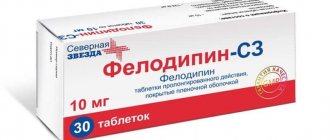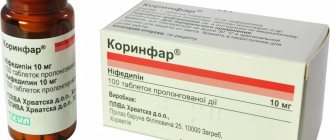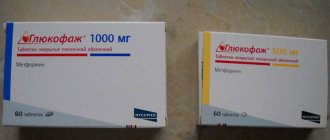Pharmacology
Pharmacological action - antianginal, hypotensive, antiarrhythmic.
Blocks voltage-dependent L-type calcium channels and inhibits the entry of calcium ions into the depolarization phase of cardiomyocytes and vascular smooth muscle cells. As a result of inhibition of the slow depolarizing flow of calcium into the cells of excitable tissues, the formation of the action potential is inhibited and the “excitation-contraction” process is uncoupled. Reduces myocardial contractility, reduces heart rate and slows AV conduction. Relaxes vascular smooth muscle, lowers peripheral vascular resistance. It has a dose-dependent antihypertensive effect in mild to moderate hypertension. The degree of reduction in blood pressure correlates with the level of hypertension (in people with normal blood pressure there is only a minimal decrease in blood pressure). The hypotensive effect is manifested in both horizontal and vertical positions. Rarely causes postural hypotension and reflex tachycardia. Does not change or slightly reduce maximum heart rate during exercise.
Long-term therapy is not accompanied by hypercatecholaminemia or increased activity of the renin-angiotensin-aldosterone system. Reduces the renal and peripheral effects of angiotensin II. The antianginal effect is due to a decrease in myocardial oxygen demand, due to a decrease in heart rate and systemic blood pressure, vasodilation of epicardial vessels, and the ability to eliminate coronary spasm. Relaxes the smooth muscles of the coronary vessels in a concentration that does not cause a negative inotropic effect. Efficacy in supraventricular tachycardias is associated with an increase (by 20%) in the effective and functional refractory period of the AV node and an extension of conduction time in the AV node (with normal heart rate, the effect on the AV node is minimal). Slows the ventricular rate in patients with high ventricular rates due to atrial fibrillation and flutter. Restores normal sinus rhythm in case of paroxysmal supraventricular tachycardia, interrupts the circulation of excitation of the re-entry type in case of junctional tachycardias and tachycardias with reciprocal conduction, incl. WPW syndrome. Long-term use is accompanied by a slight increase in the sinoatrial PR interval on the ECG. In case of sick sinus syndrome, it significantly increases the duration of the sinus cycle. With atrial fibrillation and flutter under bolus administration, it effectively reduces heart rate (by at least 20% in 95% of patients). The effect usually occurs within 3 minutes and reaches a maximum within 2–7 minutes. The slowdown in rhythm persists for 1–3 hours. With long-term infusion administration, a decrease in heart rate by 20% is observed in 83% of patients and persists after administration for a period of 0.5 hours to 10 hours. Efficiency in restoring sinus rhythm in paroxysmal supraventricular tachycardias is 88 % for 3 min. In patients with severe changes in the left ventricular myocardium (heart failure, myocardial infarction, hypertrophic cardiomyopathy), contractility, final dBP in the left ventricle and pulmonary capillary wedge pressure do not change. Has minimal effect on the smooth muscles of the gastrointestinal tract. Long-term (8 months) therapy is not accompanied by the development of tolerance and changes in the plasma lipid profile. Can cause regression of left ventricular hypertrophy in patients with arterial hypertension. At usual therapeutic doses it does not affect mortality, but in patients with signs of pulmonary congestion it increased the incidence of cardiovascular complications by 40%. In patients with acute myocardial infarction, thrombolytic therapy with plasminogen activator increased the incidence of hemorrhagic complications by 5 times.
Well (more than 90% of the dose) absorbed from the gastrointestinal tract. Bioavailability is 40% (the “first pass” effect through the liver is pronounced). Cmax is achieved in 2–4 hours (table), 3.9–4.3 hours (180 mg capsule), 5–7 hours (retard table), 6–14 hours (extended capsule). Volume of distribution 5.3 l/kg. T1/2 is 1–3 hours (with intravenous administration), 3–4.5 hours (table), 5–7 hours (retard table), 7.3–14.7 hours (caps. 180 mg ). Binds to plasma proteins by 70–80% (40% with acidic alpha glycoprotein, 30% with albumin). The action develops within 3 minutes with rapid intravenous administration, after 2–3 hours (long-term capsules) or 30–60 minutes (table) when administered orally. The duration of action when taken orally is 4–8 hours (table) and 12–24 hours (extended capsules). Metabolized in the liver by deacetylation, demethylation with the participation of cytochrome P450 (in addition to conjugation). The two main metabolites found in plasma after oral administration are deacetyldiltiazem and desmethyldiltiazem. The deacetylated metabolite has the properties of a coronary vasodilator (plasma concentration is 10–20%, activity is 25–50% of that of diltiazem), and is capable of accumulation. With a single intravenous administration, these metabolites are not detected in plasma. It is concentrated in bile and undergoes enterohepatic circulation. Excretion (including metabolites) is carried out mainly through the gastrointestinal tract (65%) and to a lesser extent by the kidneys (35%). 5 metabolites and 2–4% of unchanged drug are determined in the urine. Passes into breast milk. With prolonged oral administration, bioavailability increases and clearance decreases, which leads to increased therapeutic effects and side effects.
Based on results obtained in 21-24 month experiments on rats and mice and in vitro bacterial tests,
does not have carcinogenic or mutagenic activity. In experiments on rats, mice, rabbits, when using doses 5–10 times higher than the recommended daily doses for humans, it caused the death of embryos and fetuses, decreased survival of newborn rats and the development of skeletal abnormalities. At doses 20 or more times higher than recommended for humans, it increased the incidence of stillbirths in experimental animals.
Possible use in transplantology: after kidney transplantation (prevention of graft failure), during immunosuppressive therapy (to reduce the nephrotoxicity of cyclosporine A).
Brief information about the drug
The blood pressure medicine Diltiazem belongs to the pharmacological group of slow calcium channel blockers.
Release form
The drug is presented in a tablet form convenient for home use, as well as in the form of a solution for intravenous administration. In pharmacy chains you can find tablets and capsules characterized by the presence of a prolonged therapeutic effect.
Compound
The main active component included in the drug is diltiazem hydrochloride, presented in dosages of 30 mg, 60 mg, 90 mg or 180 mg.
pharmachologic effect
Diltiazem blood pressure tablets have a pronounced antihypertensive effect and also have antianginal and antiarrhythmic properties.
Manufacturer
The drug is produced by the Israeli pharmaceutical company Teva Pharmaceutical Industries, the Macedonian company Alkaloid AD, the Austrian company Lannacher Heilmittel and the Romanian manufacturer CO Rompharm Company SRL
Packaging of Diltiazem tablets
Storage conditions and periods
It is permissible to store the drug for no more than 2 years from the date of release. It is recommended to store the tablets at a temperature range from +15 C to +20 ° C, making sure that children and pets do not have access to the medicine!
Conditions for dispensing from a pharmacy
The dispensing of Diltiazem tablets and capsules in pharmacy chains is carried out exclusively upon presentation of the appropriate medical prescription to the pharmacist.
Price
The cost of the drug is influenced by factors such as the number of capsules in the package, the company and country of manufacture, and the dose of the main active ingredient. The average price of Diltiazem tablets varies from 90 to 270 rubles per pack.
Use of the substance Diltiazem
Angina pectoris (stable, vasospastic); prevention of coronary spasm during coronary angiography or coronary artery bypass surgery; arterial hypertension (monotherapy or in combination with other antihypertensive drugs), incl. after myocardial infarction (mainly retard forms, when beta-blockers are contraindicated), in patients with concomitant angina (in the presence of contraindications to the use of beta-blockers), in patients with diabetic nephropathy (when ACE inhibitors are contraindicated); paroxysmal supraventricular tachycardia.
Contraindications
Hypersensitivity, severe arterial hypotension (SBP less than 90 mm Hg), cardiogenic shock, left ventricular systolic dysfunction (clinical and radiological signs of pulmonary congestion, left ventricular ejection fraction less than 35–40%), incl. in acute myocardial infarction, sinus bradycardia (less than 55 beats/min), sick sinus syndrome (if a pacemaker is not implanted), sinoatrial and AV block of the II–III degree (without a pacemaker), WPW syndrome and Laun-Ganong syndrome - Levin with paroxysms of atrial fibrillation or flutter (except for patients with a pacemaker), pregnancy, breastfeeding.
Side effects of the substance Diltiazem
From the cardiovascular system and blood (hematopoiesis, hemostasis):
transient hypotension; bradycardia, conduction disorder I degree, decrease in cardiac output, palpitations, fainting, eosinophilia.
From the nervous system and sensory organs:
headache, dizziness, weakness, feeling tired.
From the genitourinary system:
peripheral edema, impaired potency (individual cases).
From the gastrointestinal tract:
dyspeptic symptoms (constipation or diarrhea, nausea, heartburn, etc., more often in elderly patients), hyperplasia of the gum mucosa (rarely).
From the skin:
sweating, redness of the skin.
Allergic reactions:
skin rash and itching, rarely - exudative erythema multiforme.
Other:
increased activity of transaminases (ALT, AST), LDH and alkaline phosphatase, hyperglycemia (certain cases).
Interaction
Increases plasma levels of carbamazepine, theophylline, cyclosporine A, digoxin. May enhance the inhibitory effect of anesthetics on contractility, conductivity and automaticity of the heart. Weakens the nephrotoxic effects of cyclosporine A. Cimetidine increases the level of diltiazem in plasma, digoxin potentiates the effectiveness in the tachysystolic form of atrial fibrillation. Antiarrhythmic drugs and beta-blockers contribute to the development of bradycardia, AV conduction disorders, and symptoms of heart failure. Antihypertensive drugs enhance the hypotensive effect. Diltiazem solution is incompatible with furosemide solution.
special instructions
Before starting to use Diltiazem, as well as in cases of development of uncharacteristic symptoms, you should consult your doctor.
Impact on the ability to drive vehicles and complex mechanisms
At the moment, it has not been proven that taking diltiazem in therapeutic doses affects the patient’s physical and mental activity. In patients characterized by high sensitivity, an excessive decrease in blood pressure, dizziness and a temporary deterioration in the ability to drive vehicles may be observed (in particular at the beginning of the course of treatment with the drug).
Overdose
Symptoms:
bradycardia, hypotension, intracardiac block and heart failure.
Treatment:
gastric lavage, administration of activated carbon, plasmapheresis and hemoperfusion using activated carbon. Calcium preparations (calcium gluconate) have antidote properties when administered intravenously; symptomatic therapy is the administration of atropine, isoproterenol, dopamine or dobutamine, diuretics, and fluid infusion. At high degrees of AV blockade, electrical cardiac stimulation is possible.
During pregnancy and lactation
Diltiazem tablets are not used to treat expectant mothers due to the negative effect of the drug on fetal development.
Since the active ingredients of the medication have the ability to pass into breast milk, during lactation the patient should either stop taking pills or transfer the baby to artificial feeding.
Diltiazem is contraindicated for pregnant and lactating women.
Precautions for the substance Diltiazem
While taking long-acting dosage forms, intravenous administration of beta-blockers is not recommended. It should be used with caution to normalize the heart rhythm in patients with impaired hemodynamics or in conjunction with drugs that reduce peripheral vascular resistance, myocardial contractility and conductivity. Parenteral administration is possible if facilities and equipment (including a defibrillator) are available to provide emergency assistance. With prolonged intravenous administration, constant monitoring of ECG and blood pressure is necessary.
Buying the drug Diltiazem in Moscow, buying in St. Petersburg and other cities of Russia is problematic. We are ready to help you buy Diltiazem at an affordable price with delivery in the shortest possible time. Before you buy Diltiazem, be sure to consult your doctor!
Where to buy Diltiazem at a low price? Diltiazem instructions for use. Diltiazem buy with delivery to Reserve
*The price is based on the monitoring carried out.
Analogues of "Diltiazem"
Generics that are similar in their active ingredients and pharmacological effect are considered to be:
- "Diazem."
- "Diacordin".
- "Cardil."
- "Aldizem".
- "Blocalcin."
- "Dilren."
- "Silden".
- "Tiaquem."
Before replacing Diltiazem with an analogue, it is recommended to consult a doctor.




